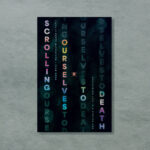On My Shelf helps you get to know various writers through a behind-the-scenes glimpse into their lives as readers.
I asked Kevin Vanhoozer—research professor of systematic theology at Trinity Evangelical Divinity School and author or editor of several books, including Mere Christian Hermeneutics: Transfiguring What It Means to Read the Bible Theologically—about what’s on his bedside table, his favorite fiction, the books he regularly revisits, and more.
What’s on your nightstand right now?
The list would be different if my nightstand were in my office—or the basement. At bedtime, I read novels only. Two I finished are still there, waiting for relocation. Niall Williams’s This Is Happiness takes place in a perpetually damp Irish village among villagers awaiting the installation of electricity while basking in a rare stretch of fair weather: “While in Faha the dictionary of rain ran to many volumes, it was quickly apparent that for sunshine there was only a single phrase: it was roasting.” Such is the backdrop of this tender story about lost love and growing up. The writing was excellent: I was transported into village culture and experienced the texture of a different place and time. It’s hard to believe Williams wrote it in the 21st century, for it reads like a classic, wise beyond its years.
Azareen Van der Viet Oloomi’s Call Me Zebra couldn’t be more different (call it “This Is Unhappiness”). It’s the story of a girl who flees Iran only to become a wandering exile, the last of a family line whose triple-A seal (Anarchists-Atheists-Autodidacts) is tattooed on her forearm. It’s a literate, intelligent, and painful first-person account of what it’s like to be “gored by history” and inhabit a world that has become “merely an unknown landscape where [one’s] heart can lean on nothing.” The narrator survives only to leave testimony to “the pile of ruins that is humanity.” After finishing the book, I wanted to return to Faha—constant rain notwithstanding.
I try to read one contemporary work of fiction for every old one in order to stay culturally literate. Tommy Orange’s There There follows 12 characters from different Native American communities, all on pilgrimage to the Big Oakland Powwow. This book too takes me out of my familiar world and “admits me to experiences other than my own” (C. S. Lewis, An Experiment in Criticism). I’m reading it because it’s my daughter Emma’s choice for our biannual family book discussion.
Louise Penny’s All the Devils Are Here is next in line. It’s the 16th in a series featuring Chief Inspector Armand Gamache and set in Three Pines, a hard-to-find village in Quebec. I enjoy these books because of their intricate plots and insights into French Canadian culture. And because Gamache always gets his man, I always get closure—a rarity in postmodern fiction.
I should also mention my morning-stand downstairs, where I start the day with a brief orientation session (some call it a “devotional”) during which I remember who I am before God. I typically use one of the Upper Room books compiled by Reuben Job and Norman Shawchuck (e.g., A Guide to Prayer for All Who Walk with God). They’re a good combination of Scripture (daily Bible readings) and tradition (reading from Christian classics). Another book that helps keep things in perspective is Stephen Jenkinson’s Die Wise: A Manifesto for Sanity and Soul. It’s never too early to hone one’s ars moriendi.
What are your favorite fiction books?
I’m partial to 19th-century British novels, when the genre was in peak form: everything from the social satire and compact prose of Jane Austen to the tragic and melancholic stories of Thomas Hardy.
A perennial favorite is Charles Dickens’s A Christmas Carol. It performs that rare feat of narrating something like a conversion in a psychologically plausible way—if one grants the existence of the ghosts of Christmas past, present, and future, that is. As a college and seminary student, I used to give public readings of the Carol, in Victorian garb, using the same version that Dickens himself did in his acclaimed performances.
George Eliot’s Middlemarch is another favorite (my daughter Mary’s middle name is “Dorothea,” after the heroine). One of its indelible characters, Casaubon, a scholar who dedicates himself to an ambitious, unrealistic, and ultimately unfeasible project, is a useful cautionary figure for me as I continue to work on my three-volume systematic theology.
Henry James was a master craftsman of novels. Many of his books (e.g., The Portrait of a Lady, The Ambassadors) include keen observations of the class and cultural differences that distinguish Americans and Europeans. As someone who lived for 12 years in the United Kingdom, I admire his powers of observation. His later works The Golden Bowl and The Wings of the Dove are remarkable less for what happens than for the way the little that happens is observed. Martha Nussbaum’s collection of essays on philosophy and literature, Love’s Knowledge, highlights the epistemological significance of James’s “finely aware and richly responsible” powers of perception, and of the linguistic and literary forms he uses to communicate his experience. James and Nussbaum have led me to ponder the significance of a systematic theology’s literary form. I also like to read James’s friend and frequent traveling companion Edith Wharton. My wife and I recently visited her house in Lenox, Massachusetts, “The Mount,” only to discover more titles of which we were previously unaware.
Marilynne Robinson’s novel Gilead is another favorite. It joins the ranks of books featuring pastors (for a complete list, see Leland Ryken, Philip Ryken, and Todd Wilson, Pastors in the Classics: Timeless Lessons on Life and Ministry from World Literature). I’ve read it twice with seminary student formation groups. It’s salutary to begin one’s ministry by reading a story about a seasoned pastor looking back on a lifetime of pastoral work.
Let me conclude by listing a number of books that helped me make peace with the Midwest soil in which I find myself a transplant: Willa Cather, O Pioneers!; William Maxwell, They Came like Swallows; William Kent Krueger, This Tender Land; Wallace Stegner, Angle of Repose; Kent Haruf, Plainsong.
What biographies or autobiographies have most influenced you and why?
Augustine’s Confessions and C. S. Lewis’s Surprised by Joy get top billing on my list of autobiographies (Peter Brown’s Augustine of Hippo and Humphrey Carpenter’s The Inklings provide good supplementary biographical information).
As a doctoral student at Cambridge University, I was invited to give one of eight University Lectures (after the esteemed church historian Henry Chadwick!) commemorating the 1,600th anniversary of Augustine’s conversion. I was working on the hermeneutic philosophy of Paul Ricoeur (1913–2005) and therefore titled my talk “How Do I Tell My Story? Augustine’s Confessions and Narrative Theology.” I’m intrigued by the way Augustine tells his life story in biblical terms. I’ve often returned to the Confessions thanks to its connection with diverse theological topics, including the nature of time and the interpretation of Genesis 1.
I’m a longtime enthusiast of Lewis’s fiction and nonfiction. Half my living-room bookcase is devoted to primary and secondary sources. What fascinates me in his autobiography is not only the way he came to faith but, equally important, the way he came to relate reason and imagination. There are lessons there for the systematic theologian.
Now I’m reading Roger Steer’s Basic Christian: The Inside Story of John Stott. Stott and J. I. Packer, the greatest British evangelical theologians of the Greatest Generation, serve as role models. Reading about them encourages me to keep going—and to cultivate the scholarly and saintly virtues that made them who they were.
What are some books you regularly reread and why?
I keep John Webster’s essay collections (The Domain of the Word, God Without Measure, Confessing God) close to hand. They’re jewels: finely chiseled examples of thinking theologically about everything, not least theology itself and the theological interpretation of Scripture. Next to Webster are Calvin’s Institutes, handy to have around when I ask myself WWCS (What Would Calvin Say?). Robert Gundry’s Commentary on the New Testament is similarly within reach so I can always hear what Bob, my mentor since college, says about a particular New Testament text.
I regularly reread Lewis’s collection of essays on theology and ethics, God in the Dock, for several reasons: first, they’re wonderful examples of how to bring Christian thinking to bear on contemporary issues; second, his analyses of modernity—or postmodernity, as in “Bulverism”—are still valuable; third, they challenge me to improve my writing; fourth, they help me think straight.
The Art of Living in Season: A Year of Reflections for Everyday Saints is another book I read regularly, not just because my wife, Sylvie, is the author but because it’s written to be read regularly. It’s about living through the church year, seasons of nature, and seasons of life as everyday saints and Christ followers. It helps me view my every location—wherever I happen to be in space and time—as a place where I can welcome Christ the King and offer him the gift of everything I say, do, and am. The book also features color illustrations of Sylvie’s botanical art, evidence of her own attention to the place where God has planted her.
What books have most profoundly shaped how you serve and lead others for the sake of the gospel?
I’ve already listed several influential books by Augustine, Calvin, Lewis, Webster, and evangelical stalwarts like Stott and Packer. All of them have shaped in one way or another how I do and teach theology. To this list let me add one more: John Frame. His Doctrine of the Word of God is a great example of how Frame manages to be faithful to Scripture (biblicist), theocentric in his theology (Reformed), and inventive in his pedagogy (creative)—the complete triperspectival theologian.
“What does it mean to be biblical?” has been my life question. Two books that have shaped how I approach it are David Kelsey’s The Uses of Scripture in Recent Theology and Bernard Ramm’s Special Revelation and the Word of God. Kelsey posed the problem; Ramm indicated a promising way forward, calling for renewed attention to language philosophy and communication studies, a call that led me to explore speech act theory.
Is it acceptable to mention my own Drama of Doctrine? Writing it altered the way I think about, and teach, doctrine and theology. In response to the all-too-common objections that theology is unbiblical and impractical, I’ve come to see doctrine as both thoroughly biblical and practical. It’s an aid to understanding the drama of redemption of which we’re a part and instruction to disciples on how fittingly to play their parts, improvising in canonically responsible and contextually relevant ways.
What’s one book you wish every pastor would read?
Tough question. May I recommend two? First, Packer’s Knowing God, preferably the edition that includes my foreword, “Knowing Packer.” Packer saw himself as a catechist. Pastors may be more than catechists, but not less. They should evidence, as Packer did, the Puritans’ gift of keeping head and heart equally ultimate.
The second book I’d recommend is Oliver O’Donovan’s Begotten or Made?, a masterclass that draws on something ancient (the Nicene Creed) to address something present and perennial: what it means to be a person and what kind of technological interventions we may or may not pursue when struggling with complex issues concerning life’s beginning and end.
What are you learning about life and following Jesus?
I’m learning that studying theology is a way of attending to God and all things in relation to God and, as such, a means of sanctification. I’m learning that praying is harder than reading, listening to God harder than writing about him. I’m learning I need to be more intentional about hearkening to God’s voice and attending to Christ’s life in me.
When I was 17, Bob Gundry encouraged me to read James Stewart’s A Man in Christ: The Vital Elements of St. Paul’s Religion. I did, but I’m still learning how deep are our riches “in Christ.” Sometimes I fear I’ve only scratched the surface.
Finally, I’m learning the art of living in season and the blessing implied by the benediction (originally from Richard Halverson) our pastor regularly bestows: “Wherever you are, God has put you there. Christ who lives in you has something he wants to do through you where you are.” I believe; help my unbelief!






































